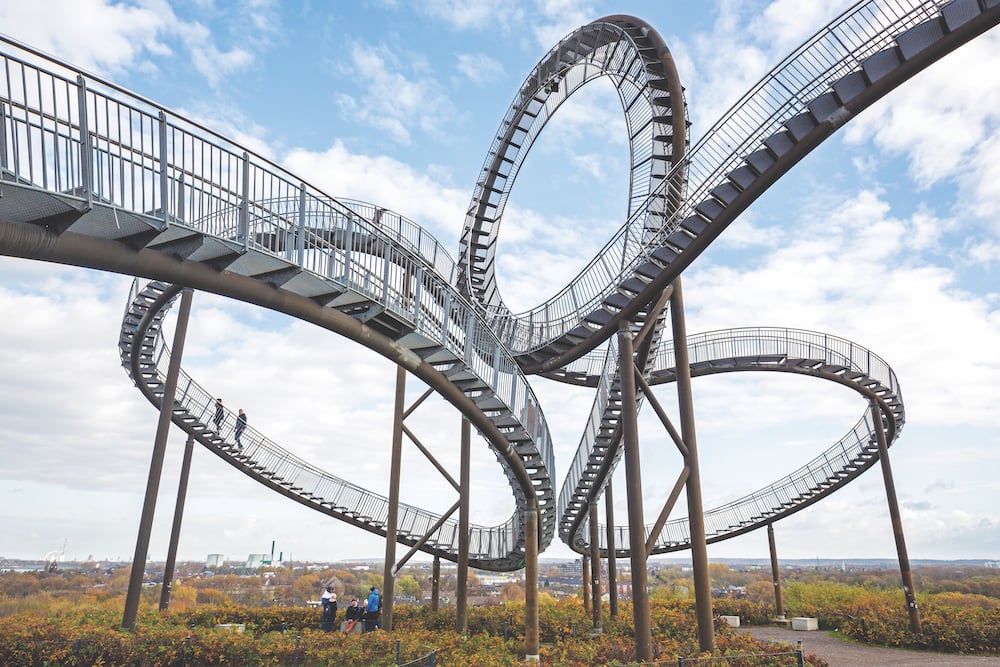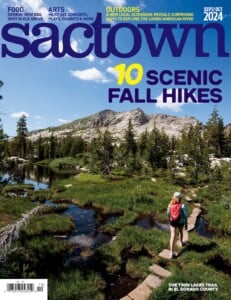Walking on Air
In Duisburg, Germany, and Pohang, South Korea, two massive works of “walkable art” have brought new life to their respective waterfronts. As a city trying to reinvigorate its own waterfront, Sacramento should walk this way too.

The Idea
Public art is critical to the vibrancy of any city, but two German artists, Heike Mutter and Ulrich Genth, have taken the idea of public art to new heights. In 2011, the duo created their first example of large-scale walkable art, called Tiger & Turtle – Magic Mountain, in Duisburg, Germany. Built atop a hill, the “walkable roller coaster” allows visitors to scale its curvilinear stairways—reaching an altitude of 69 feet—with views of the nearby Rhine River (yes, the top of the loop is blocked off from access). At night, LED lights illuminate the structure, creating a glowing beacon. In 2012, Travel + Leisure magazine dubbed it one of the “world’s coolest staircases.”
Ten years later, in November 2021, the pair unveiled their second such creation, dubbed SpaceWalk, this time in a park in the coastal city of Pohang, South Korea. At its highest point, this new sculpture stands about 80 feet above ground.
Here in Sacramento, there are no public spaces in which locals or tourists can get a panoramic view of the city. A project like this could not only provide a much-needed civic amenity, but also a stunning riverfront landmark.
We imagine it rising along either the Sacramento or West Sacramento banks of the Sacramento River. One idea: Let’s bulldoze those Jibboom Street gas stations and freeway motels that are taking up some of the city’s most valuable real estate, and commission Mutter and Genth to create a unique piece for Sacramento that gives its residents and visitors a view not only of the city and the waterfront, but also of the stunning confluence of the Sacramento and American rivers.
Or West Sacramento can make a powerful regional statement by building one in its budding riverfront district. For context, the pyramidal Ziggurat building stands 156 feet tall.
The Players
Both Duisburg and Pohang are home to about 500,000 residents—almost identical to the population of the city of Sacramento. So if they can do it, we should be able to find a way too. Whether our version is funded by the city, visionary developers or local companies, it has the potential to raise the profile of whichever city goes after it—both literally and figuratively.
The Bottom Line
In Duisburg, the city commissioned the project for a little over $2 million in 2011 (about $2.6 million, adjusted for inflation). The Korean SpaceWalk was donated to the city by a large steel company based there. Both works are made of steel and concrete. As it happens, West Sacramento is home to one of America’s most innovative concrete companies, Clark Pacific, which helped construct the Golden 1 Center, Levi’s Stadium in Santa Clara and Apple’s Cupertino headquarters, and would be an obvious partner.
Regardless of where the funding comes from, our rendition of what’s been described as the “world’s slowest roller coaster” has the potential to fast-track interest in arguably our greatest civic asset—our rivers. Let’s take that first step.
View this post on Instagram
View this post on Instagram
View this post on Instagram
View this post on Instagram


